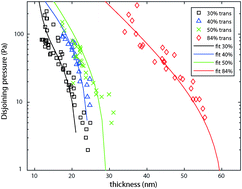Optical control of surface forces and instabilities in foam films using photosurfactants†
Abstract
Molecular interactions in thin liquid films, such as the disjoining pressure, are involved in interfacial phenomena such as emulsion and foam stabilization. In this article we show that through light stimulation we can control remotely the disjoining pressure in a thin liquid film stabilized by a photosurfactant. We stabilize a horizontal thin liquid film using a cationic photosurfactant, AzoTAB, bearing an azobenzene moiety on the hydrophobic tail which can switch from a trans to a cis conformation upon light stimulation. As the film is illuminated at specific wavelengths the AzoTAB molecules switch continuously their conformation and consequently their interface affinity. The main consequence of stimulating the film with light is increasing the ratio of cis in the film. This provokes a desorption flux, and an increase in the concentration of free surfactants, as the CMC of the cis isomer is higher than that of the trans isomer. Therefore the electrostatic repulsion between the surfactant layers that stabilize the film decreases, inducing an instability in the film thickness. For films with a thickness between 20 nm and 60 nm, we observe the formation of spherical caps up to 100 μm wide, whose shape is controlled by the competition between surface tension and disjoining pressure. The motion of these caps in the film is restrained by the surface viscosity of the surfactant layers. In addition, for thicknesses below 40 nm and depending on light intensity, we can observe flat stratified islands up to 100 μm wide, with thickness steps corresponding to the size of a surfactant micelle. We suggest that this second instability is due to the oscillation of the disjoining pressure isotherm under light.



 Please wait while we load your content...
Please wait while we load your content...